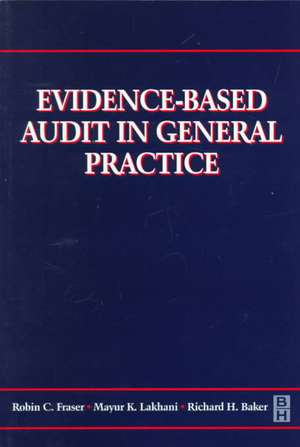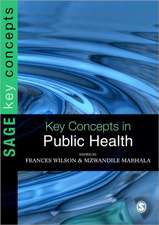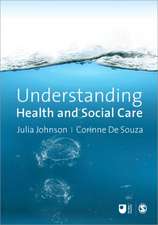Evidence-Based Audit in General Practice
Autor Robin Fraser, Mayur Lakhani, Richard Bakeren Limba Engleză Paperback – 31 iul 1998
The Eli Lilly Centre, where the three authors are based, is the foremost centre in the development of clinical audit.
Preț: 237.84 lei
Preț vechi: 250.35 lei
-5% Nou
Puncte Express: 357
Preț estimativ în valută:
45.51€ • 47.64$ • 37.88£
45.51€ • 47.64$ • 37.88£
Carte tipărită la comandă
Livrare economică 31 martie-14 aprilie
Preluare comenzi: 021 569.72.76
Specificații
ISBN-13: 9780750631044
ISBN-10: 075063104X
Pagini: 160
Ilustrații: 3 ills.
Dimensiuni: 156 x 234 x 7 mm
Greutate: 0.19 kg
Editura: BUTTERWORTH HEINEMANN
Locul publicării:United Kingdom
ISBN-10: 075063104X
Pagini: 160
Ilustrații: 3 ills.
Dimensiuni: 156 x 234 x 7 mm
Greutate: 0.19 kg
Editura: BUTTERWORTH HEINEMANN
Locul publicării:United Kingdom
Public țintă
1. GPs2. GP Registrars (postgraduate trainees);
3. Primary Care Groups
Cuprins
Foreword (Sir Donald Irvine); Preface; Evidence-based clinical audit - an overview; Developing evidence-based audit criteria and protocols; How to carry out an audit in practice; Improving the care of chronic disease - a protocol for an audit of patients with diabetes; Improving the care of acute illness - a protocol for an audit of patients with acute otitis; Improving practice organisation - a protocol for an audit of patients' routine access to their general practitioner; Improving health promotion activity - a protocol for an audit of helping patients to stop smoking; Improving mental health - a protocol for an audit of the care of patients with depression; Appendix 1 - Current Eli Lilly Centre audit protocols - list of 'must do' criteria; Appendix 2 - A check list for monitoring and reviewing audit projects; Index.
Recenzii
'As most readers will know, all three authors work at the Eli Lilly National Clinical Audit Centre. The book follows the centre's tradition of offering practical tools to support effective audit in general practice. The book starts with an overview of evidence-based audit. It then explores how to develop evidence-based criteria and protocols. The outline of key steps in carrying out an audit in general practice is a helpful summary. In the following chapters, five protocols are described in areas of importance in general practice: chronic disease (diabetes), acute illness (acute otitis media), practice organisation (access), health promotion (helping patients to stop smoking), and mental health (depression). This book will be useful to new members of staff in PCAGs, those with new audit responsibilities in Primary Care Groups, and members of practice teams.'
'Interchanges', January 1999.
'Evidence-based audit in general practice... is advertised as a way of assisting GP registrars to satisfy the audit component of summative assessment; indeed it hands it to them on a plate. The second part of the book provides audits, justifying the criteria with pre-digested evidence and offering templates for data collection. Registrars really only have to fill in the forms and think of a few ways of improving the results and will appear to have completed an excellent audit...
However, if they (or anyone else in primary care) were to take time to study this concise book, written by experts, they could learn a great deal. The first half explains why and how to do audits, and each chapter is admirably short with key points listed at the end. The exemplars include acute and chronic conditions, practice management, health promotion and mental illness, and the authors pay lip-service to critical event analysis. The evidence to support the criteria is well researched and referenced.'
Martin Rhodes, GP in Harrow, reviewing in Family Practice, Vol 16 No 1, 1999
'Interchanges', January 1999.
'Evidence-based audit in general practice... is advertised as a way of assisting GP registrars to satisfy the audit component of summative assessment; indeed it hands it to them on a plate. The second part of the book provides audits, justifying the criteria with pre-digested evidence and offering templates for data collection. Registrars really only have to fill in the forms and think of a few ways of improving the results and will appear to have completed an excellent audit...
However, if they (or anyone else in primary care) were to take time to study this concise book, written by experts, they could learn a great deal. The first half explains why and how to do audits, and each chapter is admirably short with key points listed at the end. The exemplars include acute and chronic conditions, practice management, health promotion and mental illness, and the authors pay lip-service to critical event analysis. The evidence to support the criteria is well researched and referenced.'
Martin Rhodes, GP in Harrow, reviewing in Family Practice, Vol 16 No 1, 1999



